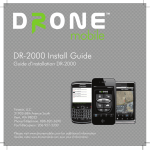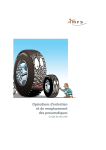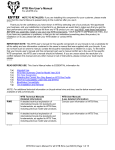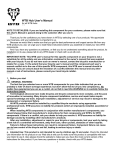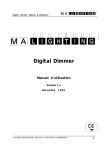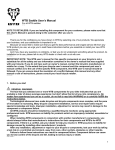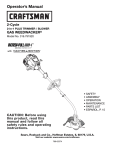Download WTB Tire User's Manual - wtb
Transcript
WTB Tire User’s Manual For all WTB tires V 11 NOTE TO RETAILERS: If you are installing this component for your customer, please make sure that this User’s Manual is passed along to the customer after you use it. GI3-0309 Thank you for the confidence you have shown in WTB by selecting one of our products. We appreciate your business, and your satisfaction is important to us. Because we would like to make sure that you get the best performance and longest service life from any WTB product you use, we urge you to read these instructions before you assemble or install your new WTB components. And if you have any questions or problems, or feel you do not understand something about the product, its installation or its use, please talk to any WTB dealer or check with us at wtb.com. GI1-0508-1 IMPORTANT NOTE: This WTB user’s manual for this specific component on your bicycle is not a substitute for all the safety and use information contained in the owner’s manual that was supplied with your bicycle. If you do not have such an owner’s manual, contact the bicycle's manufacturer or retailer for a copy. To the extent that your bicycle user’s manual and this component part user’s manual conflict as to the use of this specific WTB component, this WTB user’s manual should be followed. If you are unsure about the resolution of a conflict between this manual and any other manual or set of instructions, please consult your local bicycle retailer. GI2-0309 1. Before you start GENERAL WARNING: The fact that you selected one or more WTB components for your bike indicates that you are probably a rider of above average experience; but don’t allow that to lull you into complacency. No matter how experienced you are as a cyclist, do not fail to read this WARNING or to carefully follow the instructions below. Technological advances have made bicycles and bicycle components more complex, and the pace of innovation is increasing. Many bicycle component installation, service and repair tasks require special knowledge and tools. Improper installation, adjustment or service may result in damage to the component or component failure. All WTB products should be installed by a qualified bicycle mechanic using appropriate professional tools. WTB assumes no liability for products which are improperly installed. When installing WTB components in conjunction with another manufacturer’s components, you should always follow that manufacturer’s instructions for their components and WTB’s for WTB components. If there is a conflict, ask your dealer to help you resolve it. WTB assumes no liability for damage caused by installing other manufacturers’ products. Failure to follow these instructions can result in component failure. Component failure can cause you to lose control of the bicycle and fall, leading to serious injury or death. a. Intended Use: This product is not intended for use by children age 12 and under. Check the Intended Use information for his product on our Web site at wtb.com to make sure this product is compatible with how you intend to use it. Also please check the website to make sure you have the most current version of the instructions for this product. If you have any questions or doubts, check with your WTB dealer. IU1-1108-3 Understand your bike and its intended use. Choosing the wrong component for your intended purpose can be hazardous. Also read, in its entirety, the first WARNING of the Maintenance and Repair section of these instructions. IU2-0508-1 1 b. Compatibility: (1) The size, pressure rating, rotation direction and in some cases the intended use, are marked on the sidewall of the tire (see 2. Tire Markings below). (2) Check to make sure that your WTB tire dimensions are compatible with your rim and your bicycle fork and frame. For information on Tire/Rim Compatibility, see wtb.com. If you have any questions or doubts, check with your WTB dealer or a qualified bicycle mechanic. TI2-0309 Failure to confirm compatibility, properly install, operate and maintain any component or accessory can result in serious injury or death. CO1-0508-1 c. Correct Rim Strip: Use only the correct size rim strip or tape width, thickness and material. The rim strip or tape must be chosen to guarantee the complete covering of all spoke holes and spoke heads during use, not slip from side to side in the rim or slip around the rim’s diameter, and permit proper mounting, fit and seating of the tire and tube. The thickness of the rim strip or rim tape should not exceed 0.8 mm. Its mechanical strength should be sufficient to withstand the maximum recommended inflation pressure of the tire. Dirt, moisture and tire mounting technique can contribute to the slippage or movement of some types of rim tape. RS1-0309 Failure to use the correct width rim strip or tape on your wheel, or improper installation of any rim strip or tape can result in improper seating of the tire bead in the rim, which may lead to sudden tire deflation. Failure to make sure that the rim strip or tape covers all spoke holes completely and that it stays in place during use may lead to sudden tire deflation. Sudden tire deflation can cause loss of control, resulting in serious injury or death. If you have any questions about the correct size, material or fitting of the rim strip or rim tape, check with your WTB dealer or a qualified bicycle mechanic. RS2-0508-1 d. Correct Inner Tube: Use only the correct size inner tube, thickness, valve stem type and material for the tire. The recommended tire size ranges are marked on tube packages. You may use a properly sized inner tube with a UST tubeless tire if you make sure to remove the tubeless tire valve stem first. Failure to use the correct size, thickness, valve stem type and material inner tube with your WTB tire, or improper installation of any inner tube can result in improper seating of the tire bead in the rim, which may lead to sudden tire deflation. Sudden tire deflation can cause loss of control, resulting in serious injury or death. If you have any questions about the correct size, thickness, valve stem type, material or fitting of the inner tube, check with your WTB dealer or a qualified bicycle mechanic. IT1-0509 e. Check tire and rim: Check rim for dents or gouges and tire bead/sidewall fraying or damage. If either is damaged, see warning at section 4a. 2. Tire Markings a. Important information about a WTB tire is molded into the tire casing. Starting in the model year 2010, the Tire Markings outlined in the chart below are molded into all WTB tires. The corresponding details below explain the meaning of each Tire Marking. (1) Model Year 2010 and after Tire Sidewall Markings Tire Marking Detail 1. TIRE SIZE DESIGNATION: This is the Tire Size Designation. It is defined by the standards 54-559 organizations ETRTO and ISO. ETRTO is the “European Tyre and Rim Technical Organisation” and ISO is the “International Organization for Standardization,” which is a network of the 2 national standards institutes of 159 countries and the world’s largest developer and publisher of International Standards. The first number of the “Tire Size Designation” is the Tire Section Width (The outside width of the tire casing). The Tire Section Width in this example is 54 mm. The second number is the Tire Diameter. This measures the bead diameter of the tire. The Tire Diameter in this example is 559 mm. Common Tire Bead Diameters are: • 559 mm = 26” Mountain bike tires. • 622 mm = 700C or “road tires.” This is also the bead standard for 29” mountain bike tires. 2. TIRE SECTION WIDTH: 54 MM 3. ROTATION → 4. 35-65 PSI / 2.4-4.5 BAR / 240450 kPa (MIN-MAX) • 580 B = 584 mm This is the Tire Section Width of a tire casing on a Measuring Rim at a specified pressure for a period of time. The Tire Section Width in this example is 54 millimeters. The Tire Section Width is important for determining the ETRTO and ISO rim size recommendations for tire and rim compatibility. Mount tire so that it rotates in the direction of the arrow while riding. Minimum and maximum tire inflation pressure in different but equivalent measurements. Your tires should ALWAYS be inflated within the minimum and maximum pressure range. 35-65 PSI. Your tires should always be inflated between 35 – 65 “pounds per square inch.” This means no less than 35 psi and no more than 65 psi. 2.5 – 4.5 BAR. Your tires should always be inflated between 2.5 – 4.5 BAR * * BAR is a metric unit used to measure pressure. 1 bar = 14.50 pounds per square inch or 1 bar = 100 kPa (kilopascals) 240 - 450 kPa. Your tires should always be inflated between 240450 kPa ** 5. 6. WILDERNESS TRAIL BIKES TREAD DESIGN WTB WOLVERINE 2.2 (54 / 52) 29” ** kPa (Kilopascal) is a metric unit used to measure pressure. 1 kPa equals approximately 0.1450 psi WTB designed the tire tread. Product Name and Size of the tire. • The Product Name is on the left. The example here is a “WTB Wolverine 2.2” tire. “2.2” is part of the model name of the tire, and may be used as a reference to other tire brands’ tire widths. The accurate measure of a tire is given by ISO and ETRTO as the Tire Size Designation (Tire Section Width and Tire Bead Diameter in millimeters) and Tire Section Width. • The first number in parentheses is the Tire Section Width in millimeters. This number is the same as the Tire Section Width measure from Numbers 1 and 2, above. The Tire Section Width in this example is 54 mm. The Tire Section Width is important for determining the ETRTO 3 and ISO rim size recommendations for tire and rim compatibility. • The second number in parentheses is the Overall Tire Width, or tread width, in millimeters. This is the outermost measure of the outside knob this number determines tire clearance in the frame or fork. The Overall Tire Width in this example is 52 mm. The last number is Tire Size in US measurement. This number is the outside diameter of the tire as mounted on a rim. The Tire Size in this example is 29”. Always read the product’s User’s Manual or Instruction Manual BEFORE installing and using a product. All WTB User’s Manuals are at wtb.com/usersmanuals. The size rim which is approved for this tire by the European Tyre and Rim Technical Organisation (“ETRTO”). See Tire/Rim Compatibility Manual at this site, also ISO 5775-1 [page 6] (© 1997) and also ETRTO Section M, Subsection 13. (www.etrto.org) Mold Number Tire was manufactured in Taiwan • 7. 8. 9. 10. WARNING: READ USER’S MANUAL AT WTB.COM BEFORE USE ETRTO APPROVED: USE 19C-29C INNER RIM WIDTH C-1400N Made in Taiwan (2) In model years previous to 2010, WTB tire sidewall markings were similar to: Tire Marking Detail 1. 29 x 55/50 (55 – 622) These markings are to show the size of the tire. • The first number is the Tire Size in US measurement. This number is the outside diameter of the tire as mounted on a rim. The Tire Size in this example is 29”. • The second set of numbers is called the “Global Measuring System” by WTB, or “GMS.” The GMS in this example is “55/50.” The first number in the second set is the Tire Section Width in millimeters (the outside width of the tire casing). The Tire Section Width in this example is 55 mm. The Tire Section Width is important for determining the ETRTO and ISO rim size recommendations for tire and rim compatibility. The size rim which is approved for this tire by the European Tyre and Rim Technical Organisation (“ETRTO”). See Tire/Rim Compatibility Manual at this site, also ISO 5775-1 [page 6] (© 1997) and also ETRTO Section M, Subsection 13. (www.etrto.org) The second number in the second set is the Overall Tire Width, or tread width, in millimeters. This is the outermost measure of the outside knob this number determines tire clearance in the frame or fork. The Overall Tire Width in this example is 50 mm. • The third set of numbers (in parentheses) is the Tire Size Designation, which is defined by the standards organizations ETRTO and ISO. The first number in the parentheses is the Tire Section Width (the outside width of the tire casing). The Tire Section Width in this example is 55 mm. The second number is the Tire Diameter. The Tire Diameter is the bead diameter of the tire. The Tire Diameter in this example 4 is 622 mm. Common tire bead diameters are: • 559 mm = 26” Mountain bike tires. • 622 mm = 700C or “road tires.” This is also the bead standard for 29” mountain bike tires. 2. ROTATION → 3. 35-50 PSI / 2.5-3.4 BAR / 250345 kPa (MIN-MAX) • 580 B = 584 mm Mount tire so that it rotates in the direction of the arrow while riding. Minimum and maximum tire inflation pressure in different but equivalent measurements. Your tires should ALWAYS be inflated within the minimum and maximum pressure range. 35-50 PSI. Your tires should always be inflated between 35 – 50 pounds per square inch (“PSI”). This means no less than 35 psi and no more than 50 psi. 2.5 – 3.4 BAR. Your tires should always be inflated between 2.5 – 3.4 BAR* * BAR is a metric unit used to measure pressure. 1 bar = 14.50 pounds per square inch or 1 bar = 100 kPa (kilopascals) 250 - 345 kPa . Your tires should always be inflated between 250345 kPa** 4. WILDERNESS TRAIL BIKES TREAD DESIGN C-1400N Made in Taiwan 5. 6. ** kPa (Kilopascal) is a metric unit used to measure pressure. 1 kPa equals approximately 0.1450 psi WTB designed the tire tread. Mold Number Tire was manufactured in Taiwan b. Other Tire Marking Information: WTB tires are labeled with the model name and, where appropriate, with a decal or “hot patch” providing additional Tire and Rim Compatibility information, such as the examples below. Hotpatch (colored markings on tire sidewall) Detail The tire model is “Wolverine 2.2” This is a 29” tire This is a WTB “Tire Level and Specification” WTB has several levels of tires: Team, Race, Comp, Sport. • RACE • 60 tpi casing • Aramid bead The Tire Bead has an Aramid bead and is foldable (as opposed to wire bead). • DNA rubber compound DNA rubber compound is a specified rubber compound for the intended use. This Level Hotpatch shows the tire is a “Race” Level Tire. The Tire Casing is 60 threads per inch. 5 • XC The intended use is XC – Cross Country UST casing means the Tire Casing is compatible UST rims and wheels. TI3-0509 3. Installation & Removal a. Tires with inner tubes Before you start: (1) Ensure that the tire size selected is compatible with the rim to which it is to be fitted. In particular the nominal rim diameter of the tire size and of the rim size as shown in the relevant markings must coincide. Verify that the tire is not damaged or aged. Check that the inner tube is of a correct size for the tire size. (2) Clean the rim to remove any contamination (grease, rust, foreign material, etc.). Inspect carefully, paying particular attention to the spoke ends and valve hole, which should be smooth, free from burrs or sharp edges. Check and tighten loose spokes. Damaged or distorted spokes or rims must not be repaired and must be replaced. See WARNINGS under Maintenance and Repair below. (3) Check the rim strip or rim tape as recommended in 1.d. above. (4) Lightly lubricate the tire beads using a suitable lubricant (soapy solution or proprietary bead lubricant) so as to avoid damage during fitting. Avoid excessive lubrication, which may lead to rotation of the tire on the rim during operation. ETRTO2-0309 Do not use lubricants based on hydrocarbons or hydrocarbon mixtures (5) Mounting a tire with inner tube 5. Slowly inflate the tire with a bicycle pump or CO2 cartridge, keeping an eye on both sides of the tire to make sure it is seating evenly all the way around and at the proper depth. This is done by watching to see that the tire’s molded rim line evenly follows the rim edge. Inflate to the maximum recommended pressure marked on the side of the tire; then deflate to the desired riding pressure, making sure the pressure is within the range of recommended pressure marked on the sidewall of the tire. Check pressure with a tire pressure gauge. 1. Slightly inflate the inner tube and place it inside the tire. 2. Insert the valve stem into the valve stem hole of the rim. 3. Insert one tire bead into the rim. 4. Using hands only, no tools, insert the other tire bead, starting from the side opposite the valve stem and working both sides simultaneously toward the valve stem, until the second bead is seated in the rim. Make sure that the inner tube is not being pinched against the rim by the tire bead. After full inflation the bead line on the tire should not be more than 2 mm above the rim edge. If it is, the tire and rim are not compatible and must not be ridden. 6 6. If the valve has a retaining nut, tighten the nut finger tight against the rim. 7. Install the valve cap. (6) Removing a tire with inner tube of the tire on both sides. This will push the bead off the seat area, allowing easier disassembly. 1. Fully deflate the tire. 2. If the tire valve has a retaining nut, remove it. 4. Using tire irons, lift one bead over the rim lip all the way around the rim. 3. Starting opposite the valve, push the tire above the bead toward the center of the rim with your thumbs. Continue 360 degrees around the outside 5. Remove the inner tube. 6. Remove the tire from the rim. b. Tubeless (UST) tires [Universal System Tubeless™ Mavic (mountain bike tires). Information reproduced with permission of Mavic] The tubeless UST tire concept is based on the principle that the rim profile has a deep central groove where the tire beads are placed when mounting the tire. When beginning to inflate, the beads are pressed against the groove, creating an initial airtight seal. When the tire continues to be inflated, the beads climb up and along the rim wall and lock into place on the sidewall behind the raised ridges. The tubeless UST™ concept requires specific rim profiles and specific tires and tire beads in order to be mounted, retain air sufficiently and to be ridden safely. Before you start: (1) Ensure that the tire size selected is compatible with the rim on which it is to be fitted. See Tire/Rim Compatibility Manual at this site and ISO 5775-1 and ETRTO Section M, Subsection 13. Check the tire for any damage or ageing, particularly around the bead seating area. Tubeless tires must only be fitted on air tight crochet type rims, they may be fitted on either: - on airtight rims (‘true tubeless rims’; typically they have a valve stem in the wheel and no spoke holes in the inner rim well), or - on adapted ISO crochet type rims where an appropriate airtight rim tape is fitted to ensure the rim air tightness. (2) Check the rim for damage, particularly around the bead seating area, removing any sharp edges, burring, contamination, or foreign bodies. Pay particular attention to the nipple heads, the spoke ends (if protruding inside the rim wall) and the valve hole, which should be smooth, free from burrs or sharp edges. Check and tighten loose spokes. Damaged or distorted spokes or rims shall not be repaired and must be replaced. See WARNINGS under Maintenance and Repair below. (3) Check the airtight rim tape (if required on your rim) and replace it if damaged. Position the rim tape (if required) so that the hole for the valve corresponds with the hole in the rim and is laid properly over the well and the bead seat area. Its mechanical strength should be sufficient to withstand the maximum recommended inflation pressure of the tire and maintain air tightness of the tire rim assembly. Check that the valve is tightened correctly to the rim well. (4) Lubricate the rim (inside) and the tire around the bead seat area with a recommended lubricant, mild soapy water only. ETRTO3-0309 Do not use lubricants that contain hydrocarbons. (5) Mounting a UST tubeless tire 2. Liberally moisten the rim with specific UST tire mounting fluid or mild soapy water. 1. Use only your hands, no tools or tire levers, as they could damage the seal between tire and rim. 7 3. Insert the first bead into the bottom of the groove in the UST rim. After full inflation the bead line on the tire should not be more than 2 mm above the rim edge. If it is, the tire and rim are not compatible and must not be ridden. 4. For the second bead, start on the opposite side from the valve. 5. Insert the second bead in the bottom of the groove, working both sides simultaneously toward the valve stem and finishing at the valve. The tire must fit snugly in the bottom of the groove (8) Removing a UST tubeless tire before inflating. 1. Deflate the tire. Then, beginning at the point opposite the valve, unlock one side of the bead by forcing it into the groove of the rim. Continue along the rest of the tire. 6. Slowly inflate the tire with a bicycle pump or CO2 cartridge, keeping an eye on both sides of the tire to make sure it is seating evenly all the way around and at the proper depth. This is done by watching to see that the tire’s molded rim line evenly follows the rim edge. You should hear a “dull snapping sound” of the beads locking into place on the rim. Inflate to the maximum recommended pressure marked on the side of the tire; then, to ensure that the beads are seated correctly, completely deflate the tire. The beads should remain seated. Re-inflate to the operating inflation pressure making sure the pressure is within the range of recommended pressure marked on the sidewall of the tire. Check pressure with a tire pressure gauge. 2. Without using tire levers or other tools, pull only the first bead of the tire over the top of the rim. Continue around the rest of the rim circumference. 3. Unlock the second bead by pushing it into the rim groove, and continue all the way around the rest of the rim circumference. MAVIC1-0509 4. Remove the tire. MAVIC2-0509 4. Maintenance and Repair Many bicycle component installation, service and repair tasks require special knowledge and tools. Do not begin any installation, adjustments or service on your bicycle until you have learned from your dealer how to properly complete it. Improper installation, configuration, adjustment or service may result in damage to the component or component failure. Component failure can cause you to lose control and fall. BPSA-OM9-5 Like any mechanical device, a bicycle and its components are subject to wear and stress. Different materials and mechanisms wear or fatigue from stress at different rates and have different life cycles. If a component’s life cycle is exceeded, the component can suddenly and catastrophically fail, causing serious injury or death to the rider. Creaks, scratches, cracks, fraying and discoloration are signs of stress-caused fatigue and indicate that a part is at the end of its useful life and needs to be replaced. While the materials and workmanship of your bicycle or of individual components may be covered by a warranty for a specified period of time by the manufacturer, this is no guarantee that the product will 8 last the term of the warranty. Product life is often related to the kind of riding you do and to the treatment to which you submit the bicycle and its components. The warranty is not meant to suggest that the bicycle or a component cannot be broken or will last forever. It only means that the bicycle or component is covered subject to the terms of the warranty. BPSA-OM9-5A The “useful life” of this component (the time during which the component is safe to ride) will be reduced if (1) you use it more than the average user; (2) you are heavier than the average rider; (3) the terrain/roads you ride on is rougher than average; (4) you tend to be harder on components than the average rider; (5) you fail to follow its installation instructions or maintenance instructions, including lubrication and adjustment; (6) it must endure more adverse environmental conditions than the average component (i.e. sweat, corrosive mud, salty beach air etc.); (7) you damage/weaken it in a crash, jump or through other abuse; (8) you fail to purchase the appropriate model of product for the type of riding it endures; and/or (9) you race with the component or participate in any other type of extreme, aggressive riding such as Aggro, Hucking, Freeride, North Shore, Downhill, Jumping, Stunt Riding, etc. The more factors you meet and the more often they occur, the more this component’s life will be reduced, however it is impossible to say how much. Racing (road, mountain or triathlons) places extreme stress on bicycles and their components (like it does riders) and significantly shortens their usable or “useful” life (the time during which the component is safe to ride). If you participate in these types of events, the lifetime of the product may be significantly shortened depending upon the level and amount of racing. The “normal wear” of a component may differ greatly between competitive and non-competitive uses, which is why professional level riders often use new bikes and components each season as well as having their bikes serviced by professional mechanics after each ride. Particular care should be placed in the regular examination of your bicycle and it’s components to insure your safety. UL2-0508-1 If you engage in extreme, aggressive stunt or competition riding, you will get hurt, and you voluntarily assume a greatly increased risk of injury or death. Not all bicycles, components or equipment are designed for these types of riding, and those that are may not be suitable for all types of aggressive riding. Check with the bicycle’s or component’s manufacturer about suitability before engaging in extreme riding. When riding fast down hill, you can reach speeds achieved by motorcycles, and therefore face similar hazards and risks. Have your bicycle and equipment carefully inspected by a qualified mechanic and be sure it is in perfect condition. Consult with expert riders, area site personnel and race officials on conditions and equipment advisable at the site where you plan to ride. Wear appropriate safety gear, including an approved full face helmet, full finger gloves, and body armor. Ultimately, it is your responsibility to have proper equipment and to be familiar with course conditions. Although many catalogs, advertisements and articles about bicycling depict riders engaged in extreme riding, this activity is extremely dangerous, increases your risk of injury or death, and increases the severity of any injury. Remember that the action depicted is being performed by professionals with many years of training and experience. Know your limits and always wear a helmet and other appropriate safety gear. Even with state-of-the-art protective safety gear, you could be seriously injured or killed when jumping, stunt riding, riding downhill at speed or in competition. BPSA-OM9-2F a. Maintenance Before every ride, check the tires for excess wear, cracking, cuts or bruises. Spin each wheel slowly and look for cuts in the tread and cuts or bulges in the sidewall. Check the wheel rims for any signs of damage: dents, wobbles, bulges, cracks, deformation. Do not ride a bike with a damaged tire or rim. Riding a damaged tire or rim may lead to sudden tire deflation. Sudden tire deflation can cause loss of control, resulting in serious injury or death. Replace damaged tires and rims before riding the bike. Before every ride, check the tire pressure of both tires. The tire’s pressure rating is marked on the sidewall. 9 Never inflate a tire beyond the maximum pressure, or ride a tire with less than the minimum pressure marked on the tire’s sidewall. Exceeding the recommended maximum or minimum pressure may cause tire failure. Tire deflation can cause loss of control, resulting in serious injury or death. The best and safest way to inflate a bicycle tire to the correct pressure is with a bicycle pump which has a built-in pressure gauge. There is a safety risk in using gas station air hoses or other air compressors. They are not made for bicycle tires. They move a large volume of air very rapidly, and will raise the pressure in your tire very rapidly, which could cause the tube to explode or the tire to seat improperly. Tire pressure is given either as maximum pressure or as a pressure range. How a tire performs under different terrain or weather conditions depends largely on tire pressure. Inflating the tire to near its maximum recommended pressure gives the lowest rolling resistance; but also produces the harshest ride. High pressures work best on smooth, dry pavement. Very low pressures, at the bottom of the recommended pressure range, give the best performance on smooth, slick terrain such as hard-packed clay, and on deep, loose surfaces such as deep, dry sand. Tire pressure that is too low for your weight and the riding conditions can cause a puncture of the tube by allowing the tire to deform sufficiently to pinch the inner tube between the rim and the riding surface, causing sudden tire deflation. Sudden tire deflation can cause loss of control, resulting in serious injury or death. Replace damaged tires and rims before riding the bike. Pencil type automotive tire gauges can be inaccurate and should not be relied upon for consistent, accurate pressure readings. Instead, use a high quality dial gauge. TI3-1108-1 b. Service and Repair We strongly urge you to have any servicing or repair of your WTB components done by a qualified bicycle mechanic with the appropriate tools, knowledge and experience. If you believe that you are qualified to service, replace parts or repair a WTB component, please download, read and follow the Service Instructions at wtb.com/tech/serviceinstructions for the component which you plan to repair. SE1-0608-2 We highly recommend that you carry a spare inner tube when you ride your bike. Patching a tube or a tubeless tire is an emergency repair. If you do not apply the patch correctly or apply several patches, the patch can fail, resulting in possible tire failure, which could cause you to loose control and fall. Replace a patched tube as soon as possible. BPSA-OM9-4G c. Sealants “After market” pre-puncture sealants are most commonly liquids applied to the tire through the valve, at the time of fitting. Since these products are not approved by tire manufacturers, the compatibility of the material with the tire cannot be guaranteed. If the consumer chooses to use sealants, he/she should strictly follow all of the instructions given by the manufacturer for the sealant. WTB does not recommend the use of any liquid sealants or anti-puncture compounds with tube or tubeless tires. The chemical composition of some aftermarket sealants may react with the material of the rims, tires or valves with which it comes into contact, causing degradation of these components. Therefore consumers should check the sealant manufacturer’s recommendations. Sealants applied through the valve may impair the efficiency of the valve causing blockage or leakage as well as inhibiting routine pressure maintenance. Therefore consumers should check the sealant manufacturer’s recommendations. Some sealants may be difficult to remove from a tire to enable inspection and possible repair. 10 Liquid sealants may permeate the tire casing, either through the liner or via the site of the damage, causing adverse long-term effects on the integrity of the structure. Sealants are ineffective in tube type tires. Puncture damage sometimes renders tires unrepairable and only a fully qualified professional specialist should be entrusted to determine is a safe repair is possible. d. Maintenance, Storage, and Service Life (1) Storage of Tires, Tubes and Rim Strips Introduction In view of the harmful influence of temperature, humidity, and light, inside tire storage is essential. Whether fitted on rims or not, tires must be stored in clean conditions free from exposure to sunlight or strong artificial light, heat, ozone, (electrical machines) and hydrocarbons. If possible, mount on wheels and inflate to approximately 100 kilopascal (kPa) (1 Bar or 14.5 psi) Store mounted tire hanging vertically. Cover with opaque wheel bags. i. ii. Humidity The store room should be cool, dry and moderately ventilated. Damp or wet conditions should be avoided. Care must be taken to ensure no condensation occurs. If tires are stored outdoors they should be covered. An opaque, waterproof tarpaulin is a good cover. Water or moisture should be kept out of the tire. iii. Light There should be protection form sunlight and strong artificial light with a high ultra-violet content. Room lighting with ordinary incandescent lamps is preferable to fluorescent tubes. iv. Temperature The storage temperature should be below 35C (95F) and preferably 25C (77F) At temperatures exceeding 50C (122F), particularly in the absence of proper rotation of stocks, certain forms of deterioration may be accelerated sufficiently to affect the ultimate service life. Direct contact with pipes and radiators must be avoided. The effects of low temperature are not permanently deleterious, but can cause the products to stiffen. Care should be taken therefore to avoid distorting them during handling at that temperature. When they are taken from low temperature storage for immediate use, their temperature should be raised to approximately 20C throughout before they are put into service. v. Oxygen, Ozone, and Chemical Agents As ozone is particularly harmful, storage rooms should not contain any equipment generating ozone such as fluorescent lighting, mercury vapor lamps, electrical machines or other equipment which may produce sparks or other electrical discharges. Combustion gases and vapors which may produce ozone via photochemical process should also be excluded. Solvents, fuels, lubricants, chemicals, acids, disinfectants and the like should not be kept in the store rooms. Rubber solutions should be stored in a separate room and the administrative regulations on the storage and handling of inflammable liquids must be observed. vi. Deformation Products should be stored in a relaxed condition free from tension, compression, or other deformation since these may cause cracking or permanent distortion. vii. Rotation of Stocks Storage time is to be minimized. Stocks should be issued from the stores in rotation so that those remaining in storage are of the latest manufacture or delivery. viii. Short-Term Storage For short-term storage (up to 4 weeks) tires can be stacked horizontally, one on top of another, on wooden gratings but the height of the stacks should not exceed 1.20m (4 ft) . After 4 weeks the tires should be restacked, reversing the order of the tires. When fitted on rims, tires should be stored inflated in an upright position on in a single layer on shelf racks. ix. Long-Term Storage For long term storage tires should be stored upright in a single layer on shelf racks with at least 10 cm. clearance above the floor. To avoid deformation it is advisable to rotate them slightly once a month. x. Tubes 11 Tire tubes should either be slightly inflated, dusted with talcum and placed in the tires, or stored in a deflated condition in their boxes in small stacks (max height 50 cm./ 19 inches) – on shelves with a smooth level bottom. Slatted palettes are not suitable since they might apply pressure at particular points. They should be stored under the same atmospheric conditions set forth above for tires. (2) Tire Service Life i. The serviceability of a tire over time is a function of the storage conditions (temperature, humidity, position etc), Rubber compounds (hard or soft etc) and service conditions (load, speed, inflation pressure, terrain, road hazard or mounting damage, mounting issues, rim size, bead issues etc.) to which a tire is subjected throughout its life. Since these conditions vary widely, accurately predicting the serviceable life of a tire in advance is not possible. The older a tire, the greater the chance that it will need to be replaced due to servicerelated conditions found upon inspection. ii. Tires should be removed from service for several different reasons, including tread worn down to minimum depth, signs of damage (cuts, cracks, bulges, etc.) or signs of abuse (underinflation, overloading, etc). That is why it is recommended to have all tires inspected regularly. The tire industry continues to support the consumer’s role in the regular care and maintenance of their tires. A maintenance inspection by the consumer for the proper inflation pressure and tread wear should be made BEFORE EVERY RIDE. Additionally, the condition of a tire should be assessed regularly to determine if there are any tactile or visual signs that replacement is necessary. iii. These recommendations and guidelines cannot ensure that the tires do not exhibit an undetectable internal condition that may render them to be unacceptable for continued service. Consumers are strongly encouraged to be cognizant of their tires’ visual condition as well as any change in dynamic performance such as increased noise or vibration, either of which could be an indicator that the tires should be removed from service. ETRTO5-0309 6. Replacement Parts Use only genuine WTB replacement parts and follow the Service Instructions at wtb.com. Failure to do so could compromise the safety or performance of the component and result in component failure. GI4-0508-1 7. Warranty WTB products are warranted against defects in materials and workmanship. To read the full current warranty for your WTB product, see the Warranty section of our Web site, wtb.com GI5-0508-1 8. Making a warranty claim To make a warranty claim, see the Warranty section of our Web site, wtb.com GI6-0508-1 9. Contact Information If you have any questions or problems with any WTB product, please go to wtb.com for help. GI7-0508-1 10. Disclaimer The original English language version/meaning of these instructions supercedes all translations. WTB is not responsible for any errors in translation of these or any product instructions. GI8-0508-1 © Copyright WTB April 2009 12












